Art Fairs
The Second Paris+ Started With a Bang. Could Art Basel’s New Venture Unseat Its Flagship Fair One Day?
The fair's first day takings had stakeholders wondering whether comparisons to London and FIAC are already feeling stale.
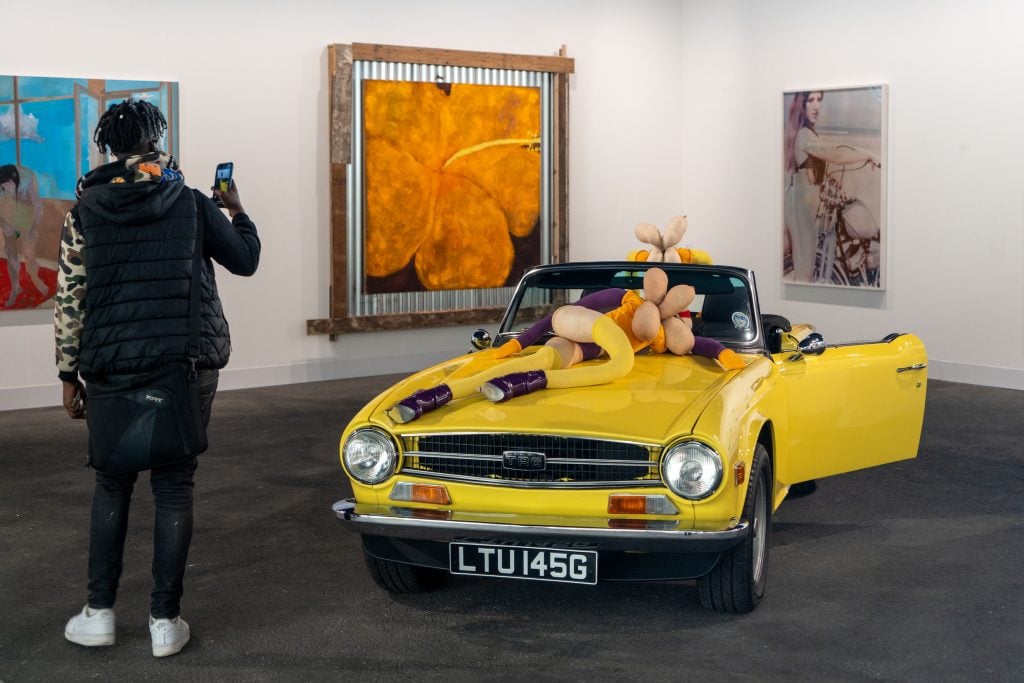
The fair's first day takings had stakeholders wondering whether comparisons to London and FIAC are already feeling stale.

Naomi Rea

On Monday evening in Paris, at the elegant residence of gallerist Kamel Mennour, a gathering of art world friends including the South Korean artist Lee Ufan chinked glasses in honor of Paris+ by Art Basel. It looked like the beginning of any ordinary art fair week—except for the worried expressions accompanying conversation about the news unfolding in the Middle East.
The situation has ignited already fragile politico-ideological tensions in France, which is now on a high alert for terrorism. Two days earlier, Ufan had been among those at the Louvre when it was evacuated due to a bomb threat. An Algerian collector sitting next to me was worried about sending her child to school.
Ahead of the fair, dealers were wondering how the uncertainty would affect commerce, and Art Basel CEO Noah Horowitz was assuring visitors of increased security measures including vehicle barriers being installed around the venue. It now feels absurd that two weeks ago, the biggest concern had been bed bugs.
Understandably, French president Emmanuel Macron, who made an early-bird appearance at the fair last year, was nowhere to be seen on Wednesday, as the fair opened to VIPs. His was not the only absence. While none of the fair’s 154 planned exhibitors pulled out, Hauser and Wirth’s Neil Wenman and Pace Gallery president Samanthe Rubell said that some U.S. clients had cancelled their flights last minute, and concerns were being floated about whether collectors from the Middle East would attend.
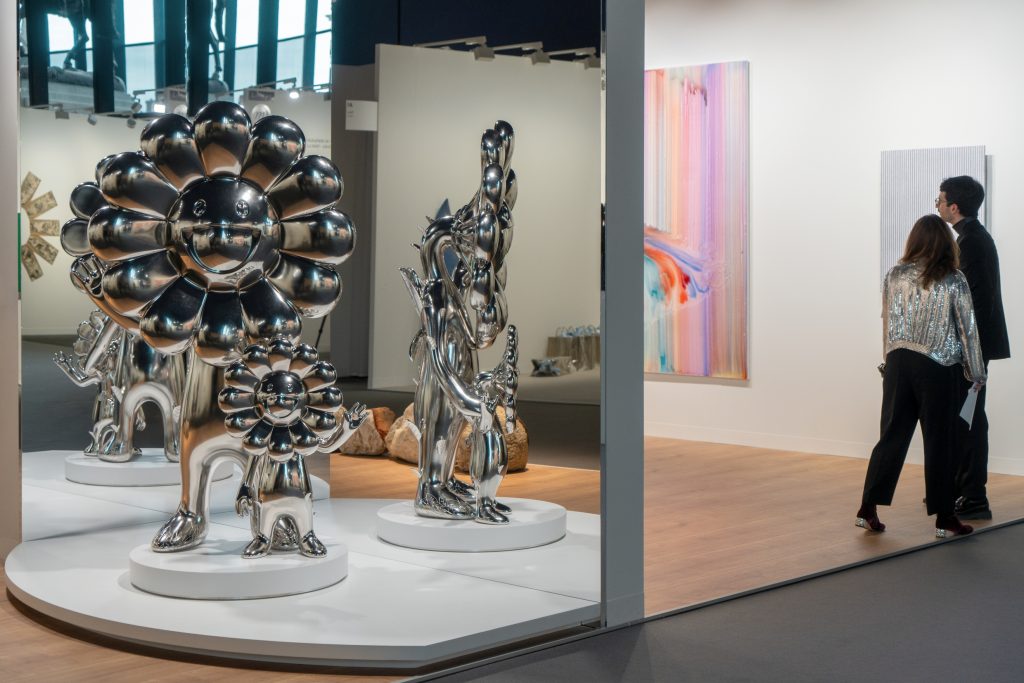
Perrotin. Courtesy of Paris+ par Art Basel.
There was already a lot at stake for the fair to live up to the expectations set by its inaugural edition last year. In 2022, visitors lauded the top notch clientele, the quality of the work on view, as well as the commerce they facilitated: galleries moved inventory at higher price points than had been achieved at its predecessor, FIAC. This year, galleries have had longer to prepare (and pre-sell), but they also have to grapple with the diminished novelty of the event, as well as different market conditions following a summer slowdown.
And yet, despite the extraordinary circumstances, things got off to a good start.
The security concerns may have put off some international visitors, but certainly not all, and at least to a French art going public living in one of the world’s most trafficked tourist centers, terror threats are sadly nothing new. Gallerist Emmanuel Perrotin was frank about the subject: “We are used to it,” he told me, before swanning off to greet Delphine Arnault—Dior CEO and daughter of mega-collector Bernard—at his booth.
That sense of pragmatism, one might even call it resilience, was palpable as collectors poured into the “ephemeral Grand Palais”—a temporary structure next to the Eiffel Tower, being used by Paris+ until 2024—for a very busy VIP vernissage. There were plenty of American accents to be heard among the crowd of first-day attendees, which also included a few Saudis discreetly operating with their advisors, Japanese collector Miwa Taguchi, and Swiss heavyweight collector Uli Sigg, as well as museum people including the Pompidou’s Bernard Blistène and the New Museum’s Massimiliano Gioni, and artists including JR.
Nor did the vehicle barriers outside the venue stop Sadie Coles from parking a boisterous Sarah Lucas car sculpture in the center of her booth, a cheeky statement that the gallerist said pretty much equated to “an advertisement” for the artist’s Tate Britain exhibition, now on view in London.
Sarah Lucas aside, coming from London last week there was definitely a marked difference in the tone of what was on offer, showing that dealers made an effort to cater to Paris’s tastes. “At Frieze, they still show a lot of British artists. It’s full of color, fun, and playful works,” said art advisor Sibylle Rochat. “In Paris, it’s much drier, more subtle and restrained, more intellectual, more conceptual work.”
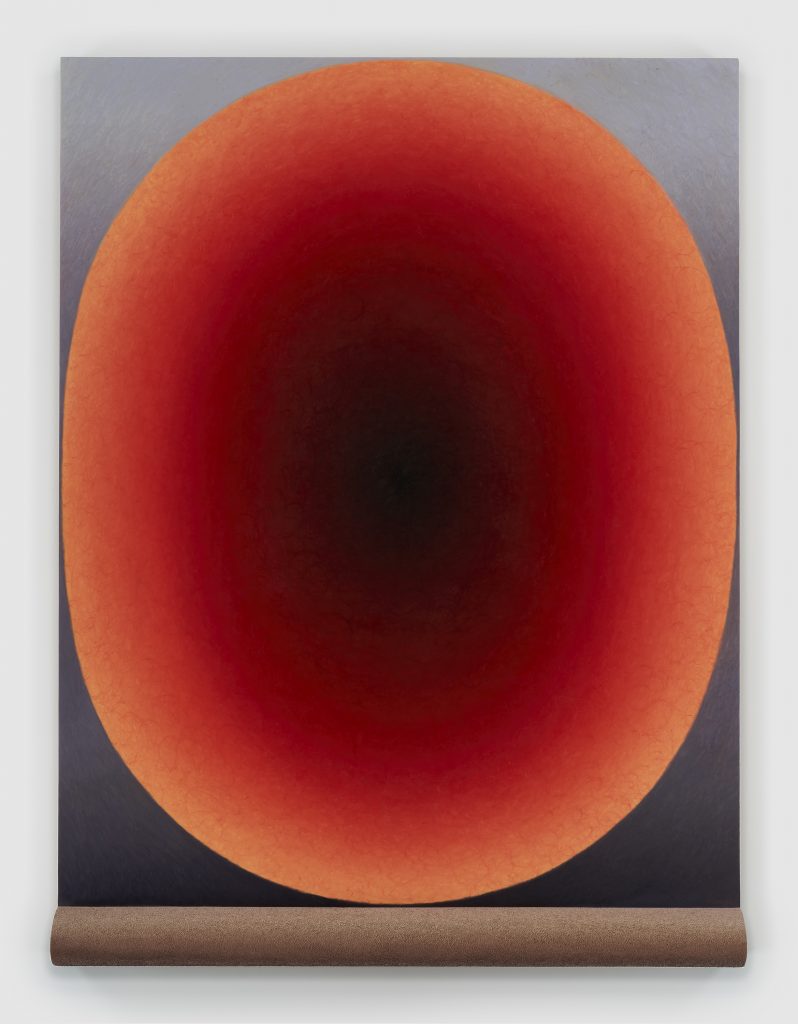
Loie Hollowell, Red-Orange Brain (2023). ©Loie Hollowell.
One theme was an alignment with the museum shows on view around the city. To fête Fondation Louis Vuitton’s historic Rothko exhibition, Pace decided on a thematic booth about the artist’s legacy, with newly commissioned works by the gallery’s artists inspired by Rothko, including one by the newest addition to the roster, Alicja Kwade, whose work, priced at $65,000, sold to a private collector before the end of the day, and a standout work by Loie Hollowell (also sold, for $450,000, by day’s end). Also on view were secondary-market pieces by some of Rothko’s contemporaries including Agnes Martin and Richard Pousette-Dart, selected in partnership with the estates.
A painting by Dana Schutz, who has an exhibition at the Musée d’Art Moderne, was on at David Zwirner’s booth (reportedly sold for $850,000). Hauser and Wirth, which was also celebrating the inauguration of its own Paris gallery this week, quickly reported a sold-out day-one booth that included a painting by Lee Lozano (with a $450,000 asking price) whose work is on view at Bourse de Commerce, and a Lorna Simpson work on fiberglass (asking $400,000), who is on view at Acacias Art Center as part of the Reiffer’s Art Initiative.
Meanwhile, Gagosian was flexing its lure of Carol Bove away from Zwirner with a standout “dead salmon”-colored intervention by the artist taking center stage on the booth. Bove’s works, two of which had sold by day’s end, were shown alongside works she selected by Tatiana Trouvé, and a beguiling 1991 Helen Frankenthaler painting entitled Reef that also sold by the end of day for an asking price we understood to be $2.3 million.
Suffice it to say that the circumstances outside the fair didn’t seem to dampen the mood. There was a lot of excited chatter that certainly looked like commerce, and plenty of sales reported by day’s end. Those include a Lee Ufan work at Mennour priced between €700,000 and €800,000, and an Anish Kapoor painting Lisson Gallery sold for £800,000. A fiber sculpture by Judith Scott shown by Andrew Edlin in the emerging sector went for around $100,000, while a work by Alioune Diagne, who will represent Senegal at the Venice Biennale next year, sold for €54,000 at Templon.
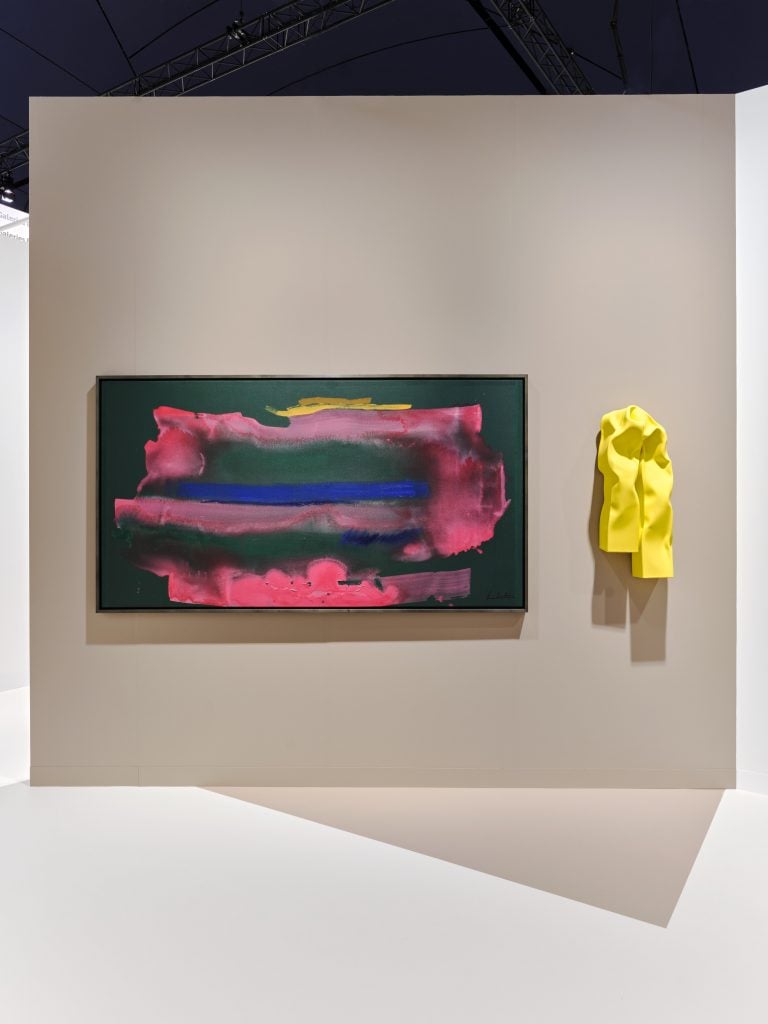
PARIS+ PAR ART BASEL, 2023. Installation view. © 2023 Helen Frankenthaler Foundation, Inc./Artists Rights Society (ARS), New York ; © Carol Bove Photo: Thomas Lannes Courtesy Gagosian
But one of the biggest questions hanging in the air for Paris+ was how well it would do at the top end of the spectrum. Last year, galleries reported being able to move much pricier artwork than they’d been able to at FIAC in the past, and this year saw a fair number of comments from dealers about doing better than London—and indeed the top price reported eclipsed the $3.2 million high reported from Frieze for a Robert Motherwell at Kasmin. But for the ambitions of this fair, both comparisons are already beginning to feel passé.
Veteran art advisor Wendy Cromwell was on the ground with clients from the U.S. “The quality of this fair is distinct and it is comparable to Basel in Basel, but in a much more condensed form,” she said. “This fair has a strong European flavor in the masters section… which I think sets it apart from the other fairs. There are outstanding works available that you wouldn’t see at other fairs like Frieze, which has a different focus and a different level of spend.”
The most expensive work we tracked down was a $40-million Rothko painting once in the collection of Thomas H. Lee at Pace’s booth, which certainly could be compared to the kind of material on view at the behemoth Swiss fair’s flagship edition. By day’s end it had not been sold, but that being said, collectors with a European sensibility are notoriously slow to pull the trigger, especially on big sales. (For context, the top price reported from the fair last year was $6.5 million, for a Robert Motherwell painting which notably did not sell on day one either.) Regardless of whether or not the Rothko finds a home by the end of the fair, the fact that Pace brought it to Paris is a gesture of confidence.
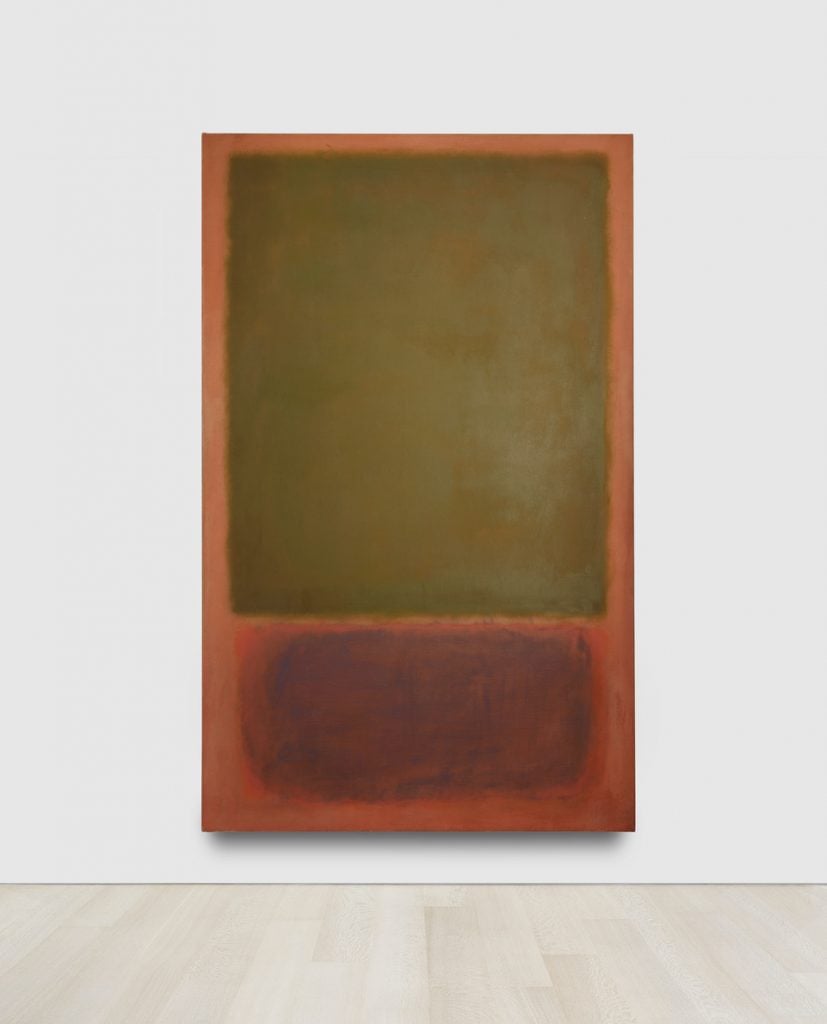
Mark Rothko, Olive over Red (1956).
© Kate Rothko Prizel and Christopher Rothko / Artists Rights Society (ARS), New York.
As for what did find a home on the upper end: multiple multimillion-dollar works exchanged hands on the VIP day (or before), including a $6 million Kerry James Marshall painting at Zwirner (who also sold two $3 million works by Alice Neel and Marlene Dumas); a $2.35 million George Condo at Hauser and Wirth; and a $2 million Robert Rauschenberg at Thaddaeus Ropac.
But questions remain.
The fair’s promising debut last year, with serious collectors, good sales, and premium material, on offer in an unequivocally more enchanting city that its Swiss counterpart, had people wondering whether it could even cannibalize its own flagship fair. This year’s event did little to resolve the question.
“If it wasn’t limited by size it definitely could,” Cromwell told me. “Paris+ is currently in a small space and the Grand Palais is not huge either. If the size can be expanded it’s got tremendous potential and I do think it will seduce people who would like to go to a Basel fair in Europe but who don’t want to go to Basel Basel.”
The verdict for now? While no one is ready to write off Art Basel proper just yet, in an ever-broadening global art market, and a trend of consolidation among the top players, more competitors may soon emerge to vie for the unofficial title of world’s premier art fair. And if you owned that premier art fair, you would probably be thinking a few moves ahead.
More Trending Stories:
Four ‘Excellently Preserved’ Ancient Roman Swords Have Been Found in the Judean Desert